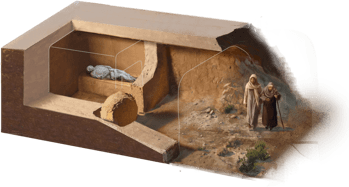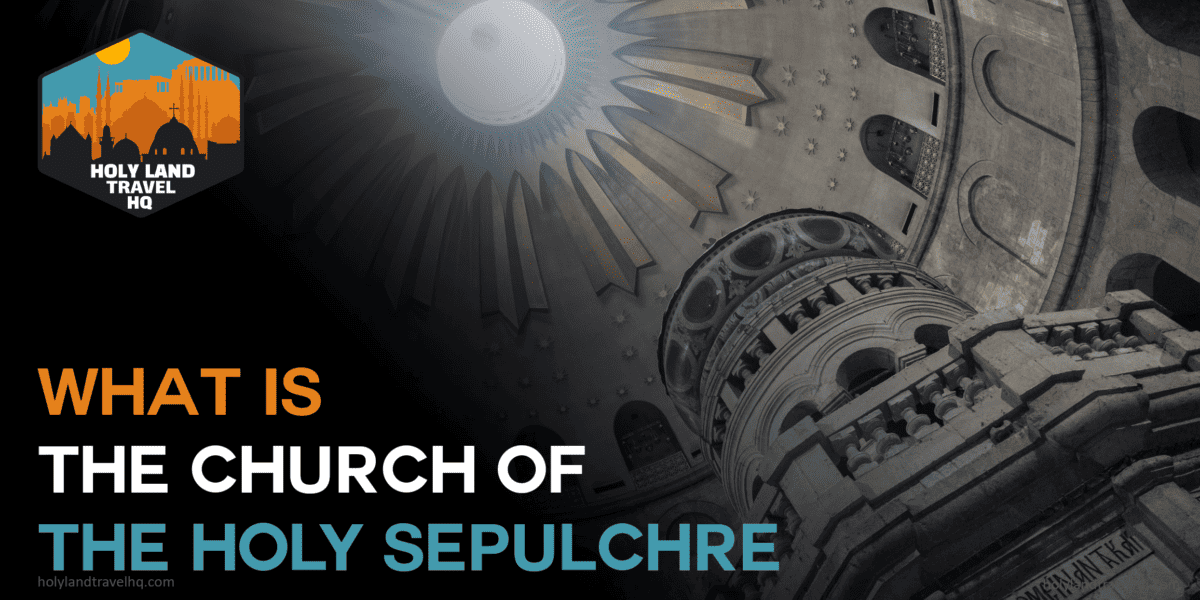
All three of the Abrahamic religions, Christianity, Judaism, and Islam, have major holy sites in Jerusalem. Judaism has the Western Wall, Islam the Dome of the Rock and Al Aqsa Mosque, and Christianity the Church of the Holy Sepulchre.
For Christians, the Church of the Holy Sepulchre is the most important site in the Holy Land. Unlike the Western Wall or the Temple Mount though, the church is often very disappointing, at least initially. When I visited Jerusalem for the first time, I’d never heard of the Church of the Holy Sepulchre. When I went inside, I was somewhat shocked. But, over time I’ve grown to like the church and I visit it often when I’m in Jerusalem.
With over 30 mini-chapels and worship areas administered by 6 denominations, there’s a lot going on inside. The church tends to surprise modern visitors and not in a good way. The gaudy ornaments, medieval iconography, and idol-esque displays can make the experience uncomfortable.
So, what is the Church of the Holy Sepulchre and why is it so sacred to Christians? The church is the traditional site of the sepulchre, or tomb of Christ. It also houses the rock of Golgotha, where Christ was crucified. Though I say these are the traditional sites, there is good evidence that they are what they claim to be. For this reason, the church is sacred to Christians. It is THE place where Christ died for our sins, was buried and rose again.
In previous posts we looked at the Dome of the Rock and the Western Wall. Today let’s take a look at the Church of the Holy Sepulchre.
Note: All links are direct. All bible verses are linked to Biblegateway.com.
What is the Holy Sepulchre?
The word sepulchre (link to Merriam-Webster dictionary) comes from the Latin word sepulcrum, meaning “to bury.” It first appeared in the English language in the 13th Century AD where it was borrowed from the French. By then, the meaning of the word referred to a tomb or burial site.
In Matthew 27:60 we find out that the tomb was new and that it was cut out of the rock. In essence it was a man-made cave.
Today, the Holy Sepulchre is less of a cave. This is because the earth and rock that the tomb was carved out of was removed. It was then encased in a protective shell called the Aedicule, which means small shrine or structure.
The Aedicule sits under the dome of the Rotunda of the Church of the Holy Sepulchre. The rotunda and Aedicule are sometimes referred to as the Anastasis. This is a Greek word that means resurrection.
The mainstay of the Church of the Holy Sepulchre is the Aedicule, or rather, the tomb of Christ itself. Although it’s not a foregone conclusion that the tomb is THE tomb, there is a lot of support for it.
What is inside the Aedicule?

After the roman temple was demolished and the tomb was cleared out, the earth around the tomb was chiseled away. The purpose of this was to level the ground in preparation for construction. It also brought the entrance of the rotunda down to the level of the tomb.
So, imagine for a moment a simple block of earth in the shape of a cube. Now imagine that instead of the cube being solid earth, the inside was hollow with an entrance on one side. This is essentially what the small structure known as the Aedicule was built to protect.
The tomb is not intricate. All that was inside in the 1st century was a kokh. This was a long slab or recess where a body was placed. Over a year it would decompose down to the bones. Once the body reached full decomposition, the bones would be placed in a small box called an ossuary.
Obviously, Jesus’s body never decomposed.
Christians visited the tomb as early as the 1st century AD. Over the centuries visitors would chip away small pieces of the kokh to take home.
The crusaders reconstructed the Aedicule after AL-Hakim destroyed it. At some point, though it is unclear when, masonry was used to protect the kokh. It wasn’t until the 2017 renovation of the Aedicule that the masonry was removed to see the original kokh.
The slab of stone showed signs of the damage and archaeologists worked intently to ensure it was properly preserved.
Today the tomb is decorated with much of the medieval flare the rest of the church touts. My first time inside the Aedicule I didn’t even know what I was looking at.
The line to get in the Aedicule can be long sometimes. Other times there is no one there.
What is inside the Church of the Holy Sepulchre?
Inside the church, there are over 30 small chapels and worship areas. Many of which are not obvious. Throughout the day, priests from the different denominations perform services and rituals. As a visitor, it’s a fascinating site that is both interesting to watch and thought-provoking.
It’s also shocking. Many visitors are repulsed by the gaudy decorations, medieval atmosphere and seemingly endless supply of icons to worship. It can come across as the antithesis of Jesus’s message.
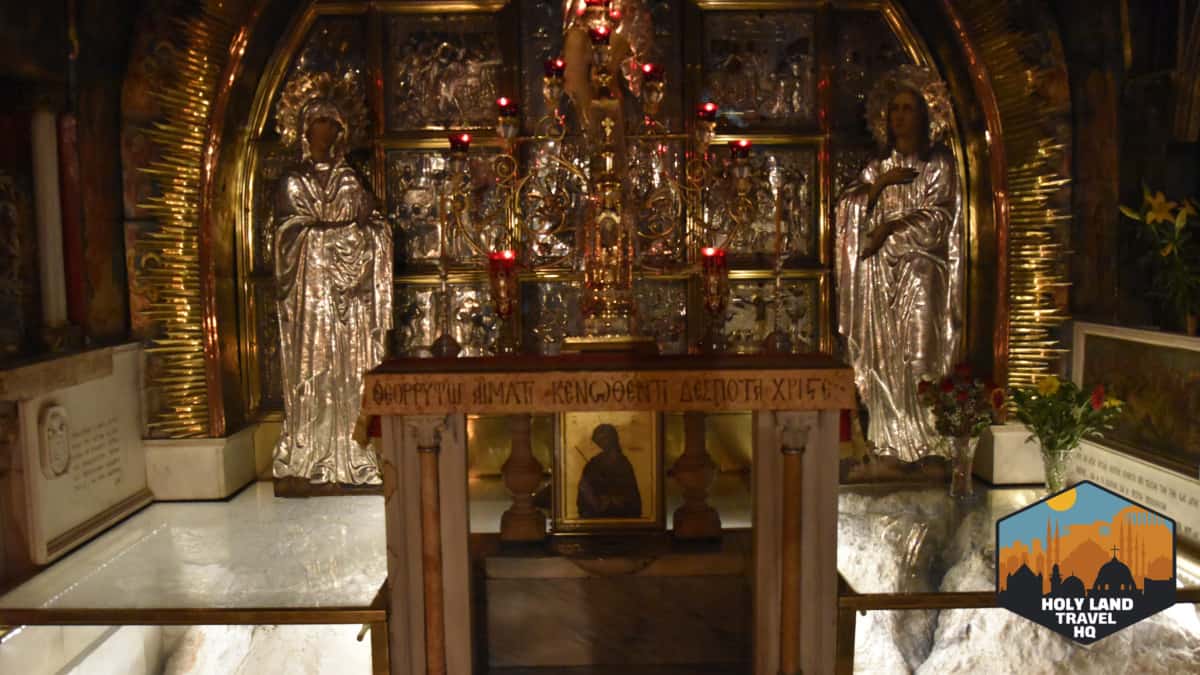
The first item you will see when you enter the church is the Katholikon. This is the slab of stone thought to be where Jesus was laid to prepare His body for burial. There isn’t much support for its claim, but a tradition has been formed around it. Many people will kneel at it to offer prayers and thanksgiving. And some kiss it.
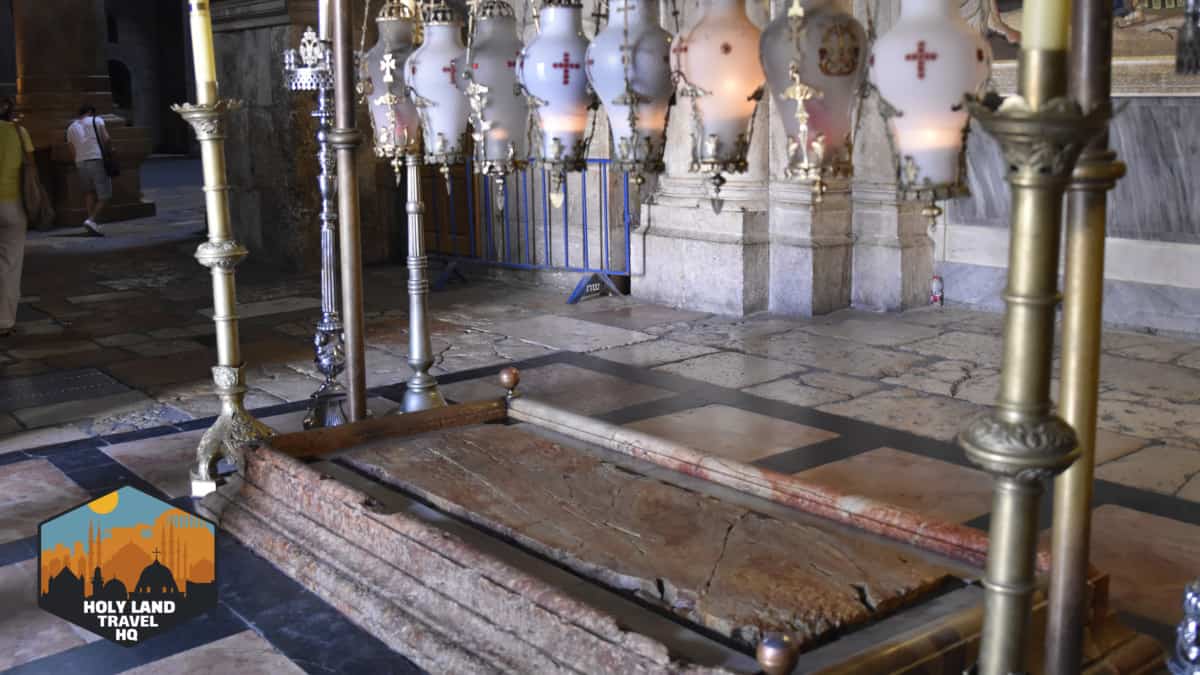
To the immediate right of the entrance is a slender stairwell that leads up to the rock of Golgotha. It is encased in glass to prevent opportunists from chipping away at it.
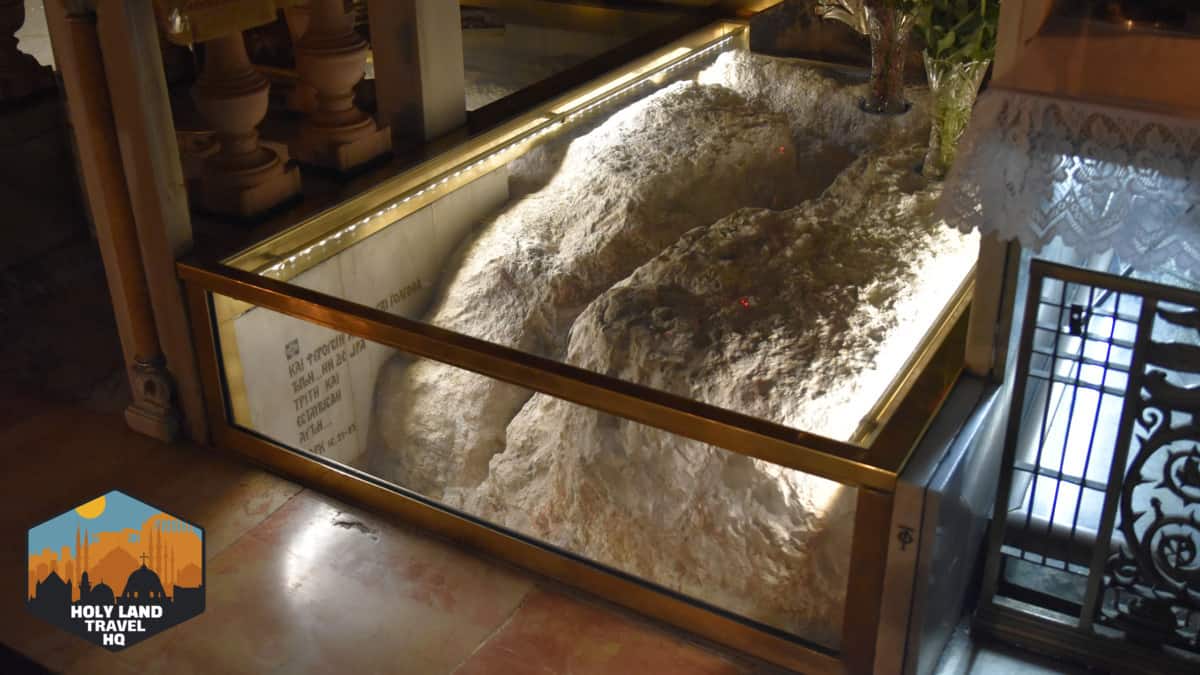
To the left of the Katholikon, the church opens up into the domed rotunda under which the Aedicule sits. Natural light illuminates the rotunda and is quite impressive. The area can fit a lot of people in it, and can, unfortunately, get quite loud.
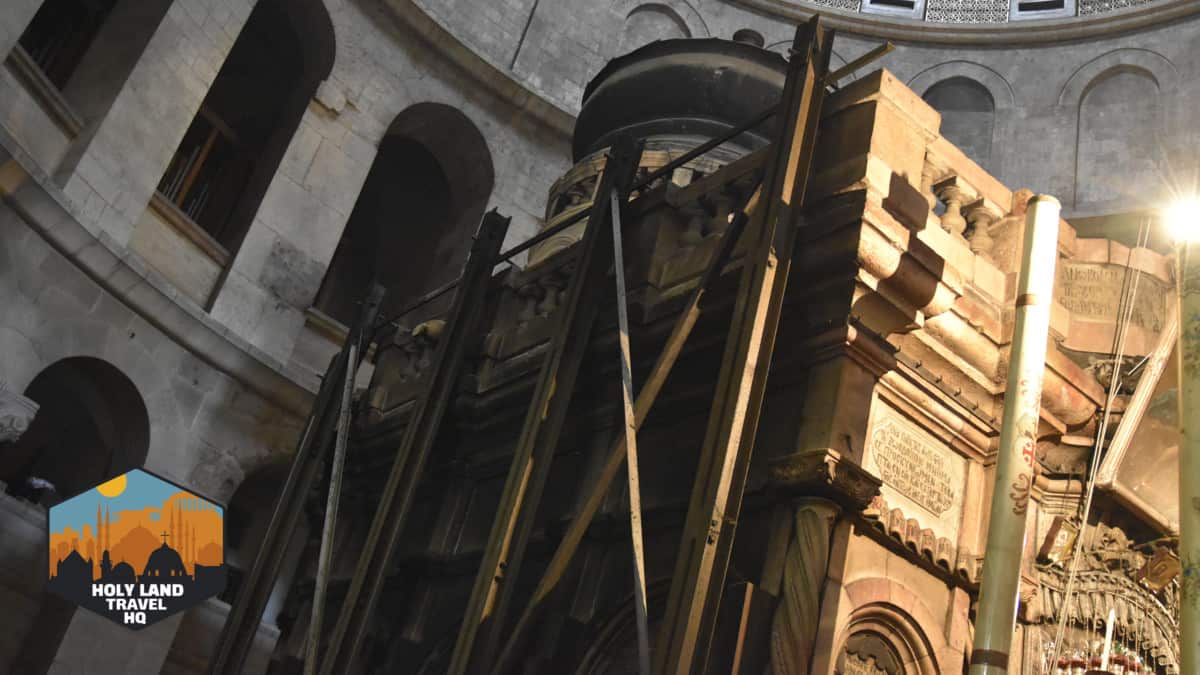
Down the corridor to the right of the Katholikon, is the Chapel of St. Helena. It was added during the crusades in the 11th and 12th centuries AD.
There is a lot to see in the church, and tours can often be quick. So make it goal circle back around on your own if you want to see more.
Can we trust what we know about the Holy Sepulchre to be accurate?
Deciphering the past can never be entirely accurate without all the information. The Holy Sepulchre has a long list of modifications over the past 2,000 years. Ancient record-keeping and archaeology certainly aren’t what they are today.
However, modern archaeology and scholarly research have turned out some rather interesting findings. And the people doing the work have been some of the best in the business. When looking at the Church of the Holy Sepulchre in particular there are three names we want to know.
First is Virgilio C. Corbo, who was a professor of archaeology at the Stadium Biblicum Franciscum in Jerusalem. Father Corbo published a 3-volume report on excavations and repairs he did on the church over a 20-year period.
The second is Father Charles Couasnon, a French architect and pastor in the Dominican Order of Preachers. He was the lead architect for the restoration work in the 1950s and 1960s. His presentation of findings to the British Academy in 1972 has been published in book form.
Finally, there is Kathleen Kenyon, a British archaeologist and one of the prominent names in biblical archaeology. She is most well-known for her work in Jericho but also spent time at the Church of the Holy Sepulchre. Because of her contributions, she is a recipient of the Order of the British Empire, which carries the title “Dame.”
Kenyon was known as a prominent anti-Zionist and held a bias towards disproving the biblical narrative. Despite the things she found at both Jericho and in Jerusalem that pointed to Biblical findings, she remained resolute in her beliefs.
Much of the research below was obtained through the Biblical Archaeological Society library. Articles included:
“Does the Holy Sepulchre Church Mark the Burial of Jesus?” by Dan Bahat. Biblical Archaeological review May/June 1986.
“The evolution of a Church – Jerusalem’s Holy Sepulchre.” by J.P.B. Ross. Biblical Archaeological review September 1976.
Does the Church of the Holy Sepulchre really mark the tomb of Jesus?
The consensus is that the site of the Holy Sepulchre was outside the city in the 1st century AD. This is further proven by the fact that part of the city wall from Herodian Jerusalem has been found. And it corroborates the claim that the site of the tomb was outside the city.
Excavations by all 3 of the aforementioned scholars revealed evidence of a quarry and garden under and around the church.
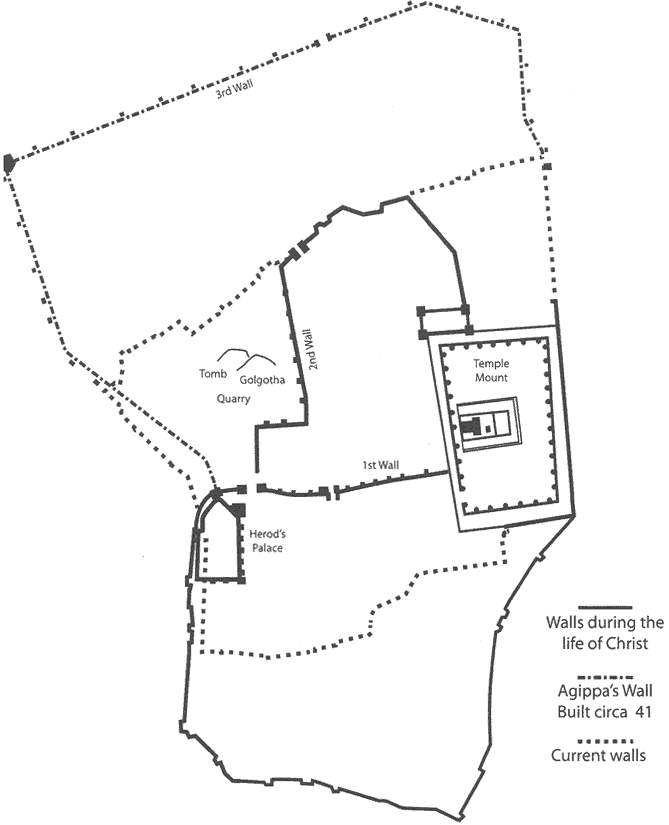
by Emily Tobler Cavins
The quarry was active as far back as the 7th or 8th century BC until the 1st century BC. Upon deactivation, a garden was allowed to grow and tombs were carved out. Father Carbo determined these tombs to date to the 1st century BC and into the time of Christ.
This also aligns with what is written in John 19:41, which states:
41At the place where Jesus was crucified, there was a garden, and in the garden a new tomb, in which no one had ever been laid.
Scholarly research into the site mostly focusses on two early church historians, Origen and Eusebius. Both historians noted the construction of a Roman temple to the goddess Venus on the site in 135 AD.
It seems unlikely that anyone would have a recollection of a tomb under the temple by 326 AD. However, the Christian community was never expelled by the Romans.
In fact, the succession of bishops in Jerusalem was never broken. And the location of the tomb was passed down through the generations. It was a holy site to the early Christians. They kept it in their corporate memory for over 300 years and the temple marked the spot.
At the council of Nicea, the Bishop of Jerusalem, Macarius, mentioned the tomb to Constantine. Which then prompted Constantine to send his mother Helena to go find it.
Where is Golgotha?
John 19:41 notes that the tomb was located in a new garden and that Jesus was also crucified there.
So, is the rock of Golgotha that we find in the Church of the Holy Sepulchre the true Calvary?
This one is harder to prove. There is plenty of meleke-type limestone in the area in which a cross could have been placed.
One story that has been told over time is about the True Cross and Calvary. The story goes that while Helena and Macarius walked by some tombs near the roman temple, the remains of a cross were found. This cross is referred to as the True Cross. The cross of Christ.
Helena supposedly determined that the rock under the True Cross was Calvary.
There are relics said to be from the True Cross in existence today. Yet they are small and delicate.
The problem is that the story of the True Cross is not corroborated by carbon dating. As in, the wood relics don’t date to the 1st century AD, but rather the 11th century AD.
Father Corbo also notes that the story itself doesn’t show up until the 11th century either.
None of this disproves the case that the rock on display in the church is the rock of Golgotha. It just shows that there is no evidence at this time.
So far, John’s account seems accurate. We’ve found a tomb that dates to the time of Christ. And it was in a former rock quarry turned garden. We can reasonably conclude that Calvary is in the general area.
Let’s go back to the idea of tradition. Sometimes a location can bear great meaning because of a tradition built around it. Even if it’s not the true location, that doesn’t mean the event didn’t happen.
What about the garden tomb and the skull-like rock next to it?
The Garden Tomb is a popular stop on the route for tour groups. Next to it is a skull-like rock formation that seems better suited for the name Golgotha. Which means “skull.”
The problem with the Garden Tomb is that it’s been dated to at least the 7th century BC. Maybe even the 8th Century. So, a century or two before the exile to Babylon.
In the gospel of John, we are told it was a new tomb that had never been used.
Another fact that is problematic is the distance from the city. In the 1st century AD, the Holy Seuplchre location was just outside the city walls in a former quarry. It’s very plausible that the Romans would have chosen a spot to crucify prisoners near the city. Specifically, near a gate.
The Garden Tomb site is definitely outside what would have been the city walls in the 1st century AD. However, it is to the north and farther away from what was the city and the Antonia Fortress.
If the Roman’s were conducting an execution to show their power, the Garden Tomb area would have been counterproductive. People would have dropped out of the procession and the impact of the event lost. Furthermore, the smell of death wouldn’t have been close enough to remind the people who was boss.

Early 20th century photos of the skull-like rock show a large cliff face with a valley across from it. If the landscape looked anything like this in the 1st century it would have been too distant to see anything. The Gospels tell a story which is more intimate. People approach the cross and watch it from a short distance.
Ultimately, the Garden Tomb and skull-like rock don’t fit the profile for an effective execution zone.
The history behind the Church of the Holy Sepulchre.
Shortly after the Romans laid siege to Jerusalem in 70 AD, the city and surrounding terrain were left in ruins. But the tomb was intact because it was underground.
In 130 AD, Roman Emperor Hadrian ordered the establishment of a Roman colony on the ruins. The new city was named Aelia Capitolina. In 135 AD, the tomb was filled to establish a solid foundation for the construction of the temple to Venus.
In 312 AD, Roman Emperor Constantine converted to Christianity. And In 326 CE he sent his mother Helena to Jerusalem to look for the tomb of Christ.
Constantine ordered the roman temple to be demolished and a shrine built. Once the temple was demolished, the filled-in tomb was discovered.
This is an important point. Macarius told Constantine that Christian tradition held the tomb of Christ to be under the Roman temple. And when they looked, a tomb was, in fact, there.
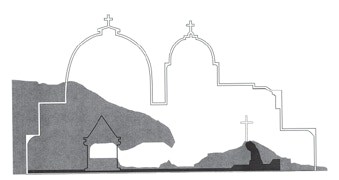
An effort was undertaken to empty the tomb of its debris. Constantine then ordered 2 structures to be built. A basilica on top of the rock of Calvary. And over the tomb, a rotunda called the Anastasis. Which is the Greek term for “resurrection.”
The earth around the tomb was etched out and a small structure or aedicule was crafter to protect it. The entire compound was referred to as the Church of the Holy Sepulchre.
It was officially dedicated on 13 September 335 AD.
Is the Church of the Holy Sepulchre the same as it was back then?
No. Over the last 2 millennia, the church and the city of Jerusalem experienced an array of wars and disasters.
May of 614 AD – a fire broke out during an invasion by the Sassanid Empire from Persia.
630 AD – the Byzantine Empire reclaimed the City and rebuilt the church under Emperor Heraclius. Byzantine control was short-lived though.
637 AD – the Rashidun Caliphate under the leadership of Omar ibn Al-Khattab conquered Jerusalem. This kicked off a period of almost 400 years of Islamic rule in the Holy Land.
Under Omar’s Caliphate, Christian sites were largely left alone.
As the story goes, Omar met with Sophronius, the patriarch of Jerusalem. Sophronius invited Omar to the Church of the Holy Sepulchre to pray, but Omar refused and prayed outside the church.
It was said that Omar did not want a precedent set for Muslims praying at the location. This would have established the site as a Muslim place of worship. As a result, the church could have been destroyed and replaced with a mosque.
By Omar not praying in the church he set a precedent for prayer elsewhere. Today this is largely the reason for leaving it alone.
746 AD – an earthquake damaged the basilica. No repairs were done though. In less than 50 years another earthquake exacted more damage, this time to the dome of the Anastasis.
810 AD – the patriarch of Jerusalem, Thomas, lead a repair project on both structures.
841 AD – a fire broke out and both structures suffered once again.
938 AD – a fire broke out in the basilica structure.
966 AD – a riot broke out after an Islamic military defeat in Syria. The Basilica was burned and the Patriarch, John VII was murdered.
Who destroyed the Church of the Holy Sepulchre?
In 1009 AD Imam Al-Hakim bi-Amr Allah of the Fatimid caliph ordered everything destroyed. The damage was catastrophic and extensive.
When news of the damage broke out in Europe, outrage obviously ensued.
But why did Al-Hakim destroy it? Didn’t Omar set a precedent?
The leadership styles of these two men were essentially oil and water. Omar is widely considered one of the greatest caliphs in Muslim history. His approach to administration and leadership was ahead of his time in a way.
When he commissioned his commanders he directed them to not be harsh lest the people become oppressed. He told them to not embellish praise because it leads to conceit. And he implored them to keep their doors open so that the strongest of the people don’t eat up the weaker ones. And lastly he told them not to see themselves as superior for that leads to tyranny.
Though we can agree that his Muslim beliefs separated him from the salvation that only Christ offers, worldly success and leadership skills are not predicated on that salvation.
Al-Hakim on the other hand is widely known as the “Mad Caliph.”
The Byzantine Empire reconstructs the church.
In 1027 AD, negotiations began between Constantine IX and Al-Hakim’s son and successor, Ali az-Zahir. An agreement was made in which the Byzantines could rebuild the Church of the Holy Sepulchre. The concession was the opening of a mosque in Constantinople.
By 1030 AD the church reconstruction was complete and the church was mostly in the form that we see today. I say “mostly” because the crusader era added a great deal to how the church visually appears today.
The Crusades and the Church of the Holy Sepulchre.
In 1096 AD, at the call of Pope Urban II, the First Crusade began. Soldiers and pilgrims alike, with their families, left Europe and headed towards Constantinople. In 1099 AD, the armies of Raymond of Toulouse and Godfrey de Bouillon reclaimed Jerusalem for Christianity.
Control of Jerusalem didn’t last long, as the Sunni Sultan, Saladin defeated and expelled the Christian army in 1187 AD.
During their period of control, the crusaders rebuilt, fortified, and decorated the Church of the Holy Sepulchre. This is why much of the ornate fixtures and décor come across as medieval. Though they had left, the European medieval culture of the crusaders remained.
Once the Muslims regained control of Jerusalem in 1187 AD, many churches were looted, except the Church of the Holy Sepulchre. Though none of the sources I read stated why the likely answer could be the precedent set by Omar.
In 1229 AD, a treaty ended what is known as the 6th Crusade. It essentially resulted in the arrangement we have today. The Dome of the Rock and Al-Aqsa Mosque would remain under Muslim control. And the Church of the Holy Sepulchre would be under Christian control.
Altogether, there were between 10 and 15 crusades over a 200-year period. The purpose of these campaigns was to regain Christian control of different parts of the Holy Land. This included Jerusalem but also areas as far north as Constantinople and as far south as Egypt.
What is the Church of the Holy Sepulchre used for?
The Church of the Holy Sepulchre has been an active church and pilgrimage site for almost 1,700 years. This was and remains to be its main purpose.
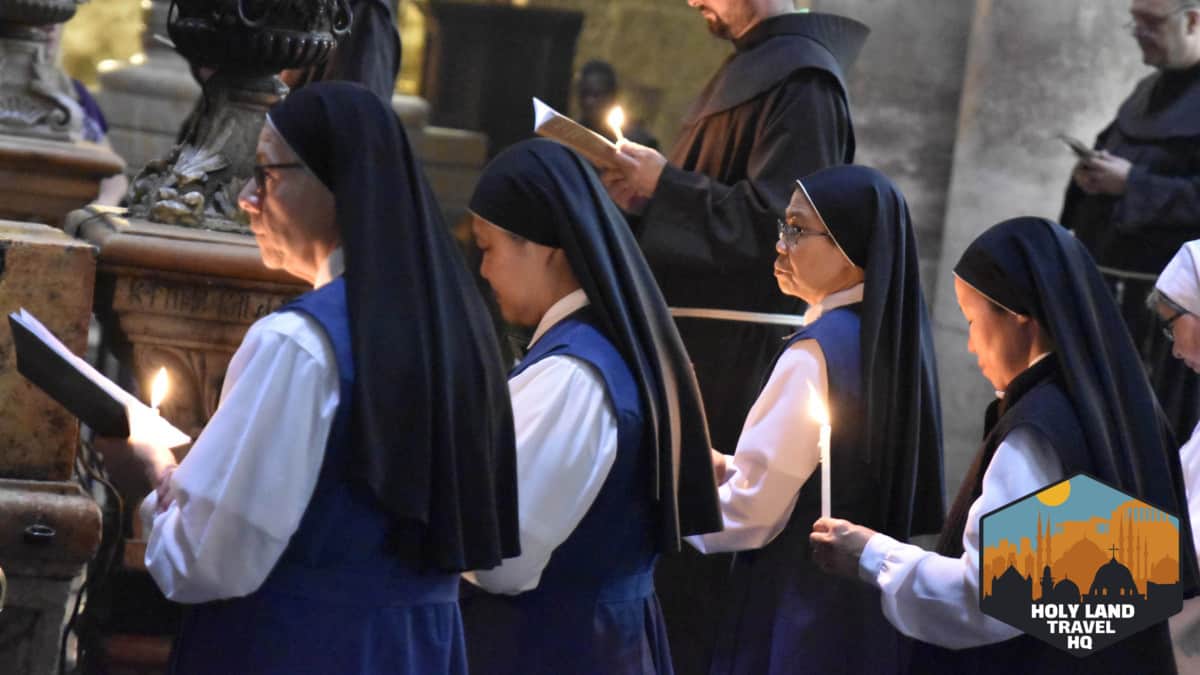
Today, tourists still visit the Tomb of Christ as they did in the 1st century AD. Worship activities are also conducted throughout the day to pay homage to Christ’s sacrifice on the cross.
At least 5 denominations facilitate services and administer the building. Greek Orthodox Christians, Roman Catholics, Armenian Orthodox Christians, Coptic Christians, and Syrian Orthodox Christians. Ethiopian Christians also have a small role in the administration.
The denominational divides are both encouraging and disheartening. It is encouraging to see the whole of Christianity taking care of the church. But the inter-denominational bickering and administrative gridlock can distract from the purpose of the church. The immovable ladder above the entrance is a prime example. Though I wonder if, by now, it has become an endearing piece of history instead of a source of argument.
There are a bevy of services throughout the day and any of them are interesting to observe. For a list of services and service times check out this link to holysepulchre.com. The site does not advertise its owner but it has good information.
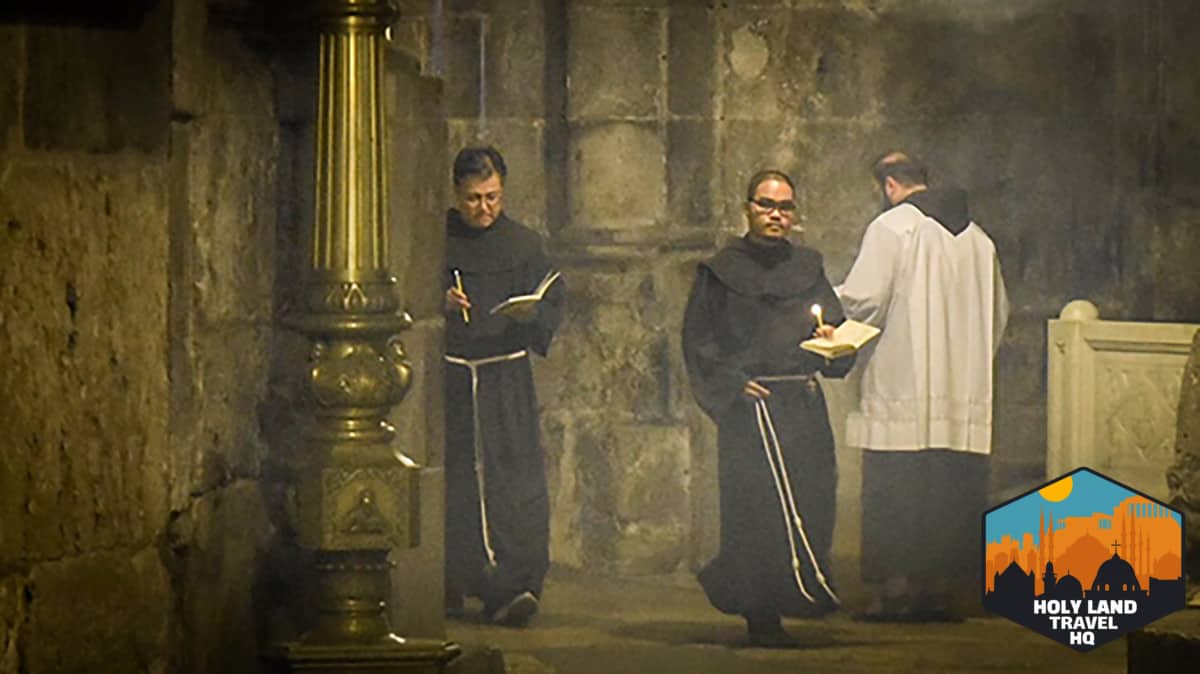
When observing a service, you aren’t allowed to participate. Follow any directions by the priests to open walkways or stand aside. You can take as many pictures as you like, just don’t be obnoxious or get in the way.
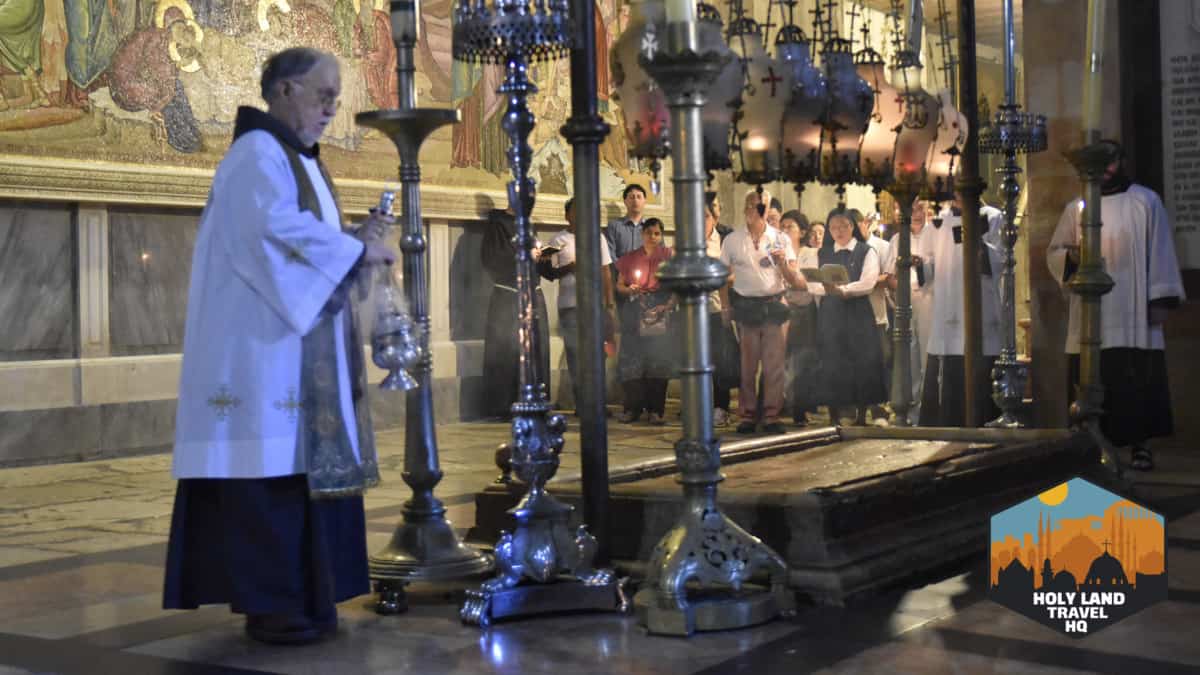
The closing of the door ceremony at night is also an interesting event. It happens rather quick and ends abruptly so make sure you get their early. In the summer months, it happens around 9 pm and 7 pm in the winter months.
Finally, there is no souvenir shop for the church. Sorry.
References:
- Visitors page by holysepulchre.com
- “Holy Sepulchre.” By Encyclopedia Britannica
- “Church of the Holy Sepulchre.” by seetheholyland.net
- “Precious relic of the True Cross.” by truecrosschurch.org
- “Church of the Holy Sepulchre.” by churchoftheholysepulchre.net
- “Does the Holy Sepulchre Church Mark the Burial of Jesus?” by Dan Bahat. Biblical Archaeological review May/June 1986.
- “The evolution of a Church – Jerusalem’s Holy Sepulchre.” by J.P.B. Ross. Biblical Archaeological review September 1976.
- “A Pilgrim’s Guide to the Holy Sepulchre and Golgotha in Jerusalem.” by Emily Tobler Cavins.
- “Church of the Holy Sepulchre.” by Wikipedia


